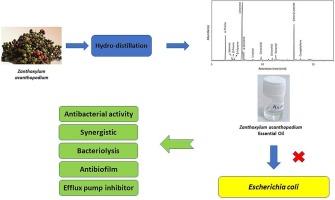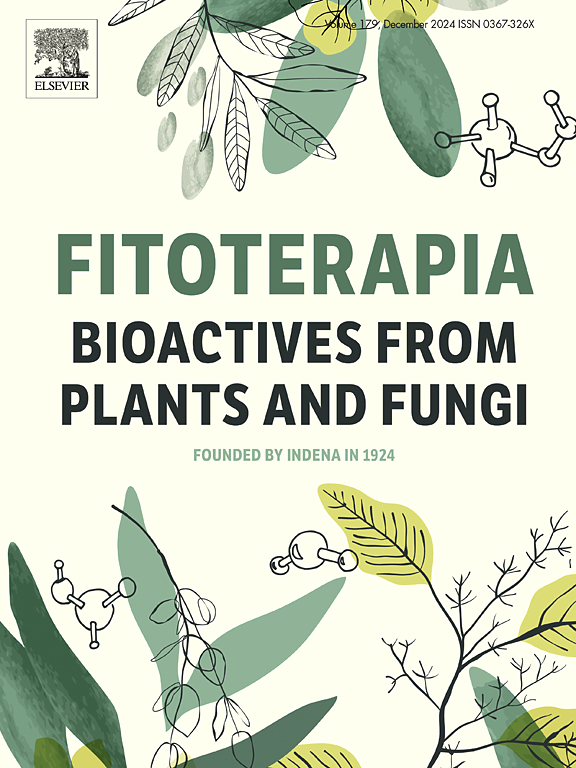Chemical profiles and antibacterial actions of Zanthoxylum acanthopodium DC. Essential oil growing in Indonesia
IF 2.5
3区 医学
Q3 CHEMISTRY, MEDICINAL
引用次数: 0
Abstract
Foodborne illness caused by pathogens has been a major health problem. Antibacterial resistance renders therapeutic options for treating the condition more limited, hence there is a growing interest in finding novel antibacterial alternatives. Zanthoxylum acanthopodium (Rutaceae) essential oil (ZAEO) has a substantial potential to suppress the growth of bacterial infections. This study was conducted to evaluate antibacterial activity of ZAEO against four species of foodborne pathogens that cause potential infections. The checkerboard assay was used to identify synergistic effect of ZAEO and tetracycline, while bacteriolysis test was applied to evaluate the ability of ZAEO releasing material genetics of bacteria, inhibiting biofilm formation, and suppressing efflux pump. The oils of Z. acanthopodium was evaluated and showed that the highest constituents were limonene and geranyl acetate at 47.13 % and 23.84 %, respectively. These oils have the strongest ability to inhibit Escherichia coli compared to other pathogens with MIC value of 62.5 μg/mL. ZAEO and tetracycline also presented a synergistic effect against E. coli with FICI value of 0.37. Moreover, this combination of ZAEO and antibiotic shown as potential antibacterial agent by several mechanisms such as, decreasing biofilm formation, releasing ions, rupturing membrane cells, and suppressing the efflux pump of E. coli. It can be concluded that ZAEO and tetracycline presented a promising antibacterial activity, which can be explored further to develops antibacterial agents against foodborne pathogens.

Zanthoxylum acanthopodium DC.精油生长在印度尼西亚。
由病原体引起的食源性疾病一直是一个重大的健康问题。抗菌药的耐药性使治疗这种疾病的方法更加有限,因此人们对寻找新的抗菌替代品越来越感兴趣。Zanthoxylum acanthopodium(芸香科)精油(ZAEO)具有抑制细菌感染生长的巨大潜力。本研究评估了ZAEO对四种可能引起感染的食源性病原体的抗菌活性。采用棋盘试验来确定ZAEO和四环素的协同作用,同时采用细菌溶解试验来评估ZAEO释放细菌遗传物质、抑制生物膜形成和抑制外排泵的能力。对刺五加油进行了评估,结果表明,含量最高的成分是柠檬烯和乙酸香叶酯,分别为 47.13 % 和 23.84 %。与其他病原体相比,这些油对大肠杆菌的抑制能力最强,其 MIC 值为 62.5 μg/mL。ZAEO和四环素对大肠杆菌也有协同作用,FICI值为0.37。此外,ZAEO 和抗生素的组合通过多种机制显示出潜在的抗菌作用,如减少生物膜的形成、释放离子、破坏膜细胞和抑制大肠杆菌的外排泵。由此可以得出结论,ZAEO 和四环素具有良好的抗菌活性,可以进一步开发针对食源性病原体的抗菌剂。
本文章由计算机程序翻译,如有差异,请以英文原文为准。
求助全文
约1分钟内获得全文
求助全文
来源期刊

Fitoterapia
医学-药学
CiteScore
5.80
自引率
2.90%
发文量
198
审稿时长
1.5 months
期刊介绍:
Fitoterapia is a Journal dedicated to medicinal plants and to bioactive natural products of plant origin. It publishes original contributions in seven major areas:
1. Characterization of active ingredients of medicinal plants
2. Development of standardization method for bioactive plant extracts and natural products
3. Identification of bioactivity in plant extracts
4. Identification of targets and mechanism of activity of plant extracts
5. Production and genomic characterization of medicinal plants biomass
6. Chemistry and biochemistry of bioactive natural products of plant origin
7. Critical reviews of the historical, clinical and legal status of medicinal plants, and accounts on topical issues.
 求助内容:
求助内容: 应助结果提醒方式:
应助结果提醒方式:


